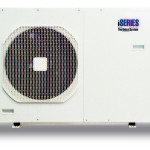DOE Student Design Competition Turns out Zero Energy Ready Home
ST. LOUIS, Mo. — The winning entry in the Department of Energy 2015 Race to Zero Student Design Competition includes a heating and air-conditioning system that is so efficient, it would generate only $282 in annual heating costs, and $38 for cooling. Energy modeling shows that adding solar technology would more than offset the energy costs, reducing the energy bills to zero and qualifying it as a DOE Zero Energy Ready Home.
Students and faculty from the University of Minnesota team won the grand prize for their energy-efficient design of a three-bedroom, two-bath home. The team consulted with engineers from heating and air conditioning manufacturer Unico, Inc., on calculations and efficiencies for the proposed home.
Unico’s high-velocity forced air system features two-inch diameter, flexible insulated ducting that has zero leakage, so there is no heating and cooling going into attics and other spaces that don’t need it. The air-conditioning unit removes 30 percent more humidity from the air than traditional air handlers, allowing homeowners to set the thermostat higher in the hot summer months but feeling the same cool comfort as if it were set lower.
 The Unico equipment specified in the design included software-driven motor technology that delivers even airflow to each part of the home, eliminating stratification and creating an indoor environment with less than 2 degrees of temperature difference across the built space. The university team chose the high-SEER Unico iSeries inverter heat pump as the outdoor solution, while the dual fuel system also included a Unico hydro coil, fed by the energy-efficient Polaris gas water heater.
The Unico equipment specified in the design included software-driven motor technology that delivers even airflow to each part of the home, eliminating stratification and creating an indoor environment with less than 2 degrees of temperature difference across the built space. The university team chose the high-SEER Unico iSeries inverter heat pump as the outdoor solution, while the dual fuel system also included a Unico hydro coil, fed by the energy-efficient Polaris gas water heater.
The Unico System’s small-duct technology utilizes a 7-inch plenum with 2-inch flexible ducts, which is one-fourth the size of a traditional delivery system. No soffits are required, providing more cubic feet of built space for the owners. Comfortable, quiet, energy-efficient heating and cooling, combined with more built space and no architectural compromise of the home, were integral elements in the design of the winning structure.
The University of Minnesota team was awarded the grand prize in April at the National Renewable Energy Laboratory in Colorado. Students from 33 teams presented their designs to a panel of experts that included high-performance homebuilders, building science professionals, building product manufacturer technical experts and national laboratory research scientists.
The Race to Zero is an annual competition, open to college students and faculty. It is based upon a real-world scenario where a builder needs to update an existing house plan to a high-performance house design or is developing a new high-performance home product line. The mandatory performance target is the DOE Zero Energy Ready Home specification. By definition, these high-performance homes are so energy efficient that renewable power can offset most or all the annual energy consumption.
The 2015 competition results can be viewed online at www.energy.gov (enter “Race to Zero” in the search bar).



